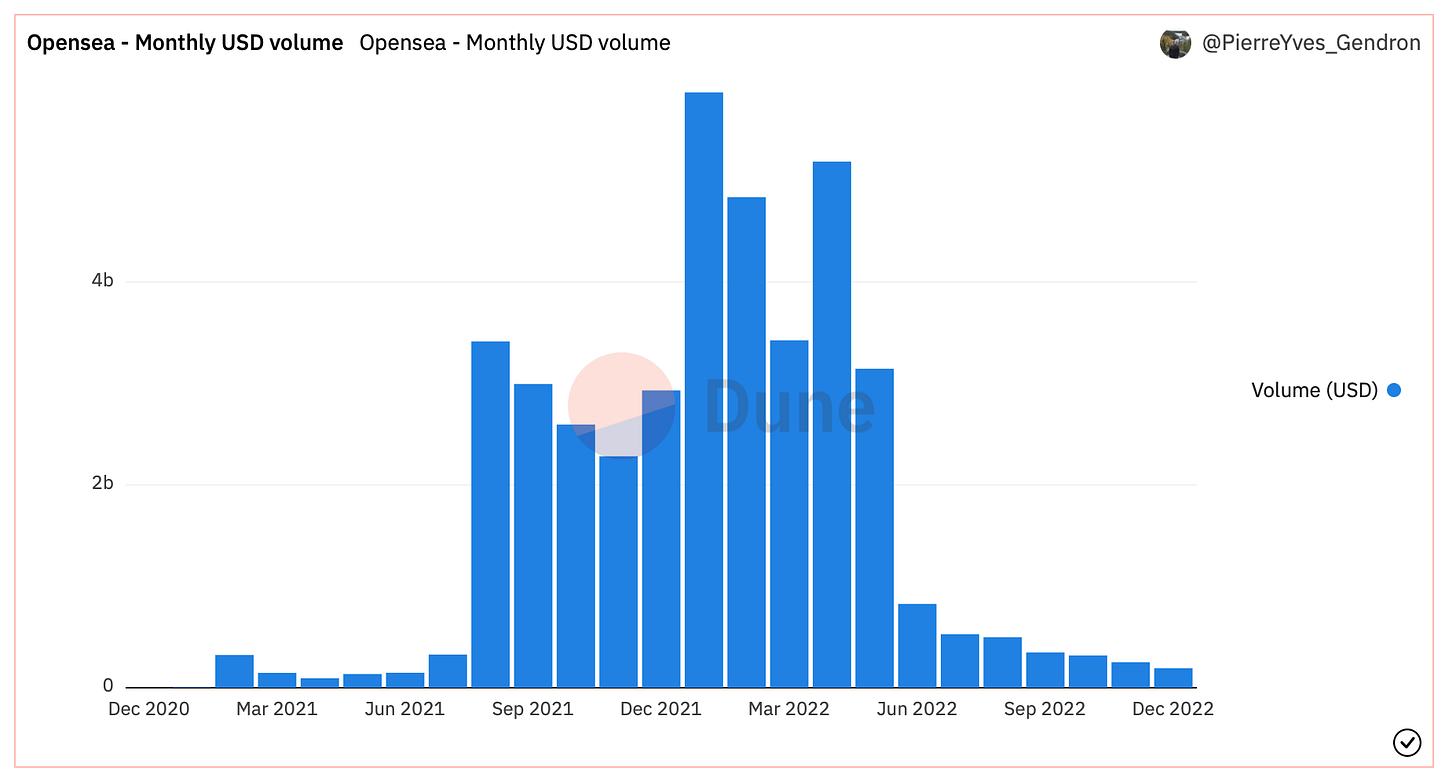Are NFTs Dead? Debunking Three of the Biggest Myths
People outside of the NFT community often say that NFTs are used exclusively for money laundering or that they’re Ponzi schemes. Rather than addressing these, I'll refer to the first eight posts in my "NFTs for Rookies" series, where I explain the potential for NFTs to be uncensorable, immutable, and interoperable digital property and why those features are beneficial.
That being said, there are a few myths about NFTs that have a kernel of truth to them and are worth exploring in more depth because they’re frequently repeated. These myths include the idea that NFTs are either dead, environmentally harmful, or simply a useless link to a URL.
In this post, we'll discuss why the market being down 96% doesn't tell the full story, then delve into the environmental impact of NFTs and the technological advances that made them sustainable. And finally, we'll go over what you're actually buying when you buy an NFT. Is it really just a link to a URL?
1. NFTs Are Dead
It's no secret that the NFT market has seen a significant decline compared to earlier in the year. In January 2022, NFT sales on OpenSea reached a peak of almost $6 billion, while in November of the same year, sales on the platform totaled just $250 million – a 96% decrease in volume.
But it's important to remember that the crypto market runs in cycles. When the price of an asset goes up quickly, it creates a bunch of excitement and brings in new investors, which leads to even higher prices. People fear that they're missing out on generational wealth and buy assets only with the intention of selling them quickly for a profit. Eventually, some investors begin to take profits on their assets, which causes the price to go down, and it can continue to go down as the non-believers are flushed out of the market. This downward trend continues until some investors–sometimes even the believers–are about ready to give up, which creates a bottom.
Crypto is known for its volatility, but it has consistently reached higher lows over time as adoption increases. For example, in 2013, Bitcoin reached an all-time high of $1,200 before falling to $200. In 2017, the same pattern occurred, with Bitcoin reaching $19,000 before bottoming at $3,000. The same can be seen with NFTs. While the $250 million in sales on OpenSea in November seems small relative to the beginning of the year, let's look at 2018 when the platform had just $50,000 in sales for the same month.
It may be tempting to declare NFTs as a failed experiment, but it'd be premature to do so. Quality NFT projects are still going strong, with the cheapest CryptoPunk or Bored Ape going for more than $75,000. Additionally, new projects are still finding success, with popular podcaster Tim Ferriss recently launching an NFT project that sold out in under an hour, raising over $2 million, while Trump did the same with his collectible project and raised $4 million.
Additionally, the NFT market has seen significant developments in recent months. Reddit has launched collectible avatars for all of its users, introducing four million new people to digital wallets. Facebook and Instagram have also introduced a way to link digital wallets to profiles, and new marketplaces like Blur.io and Uniswap's NFT marketplace aggregator have entered the scene. Even Starbucks is getting in on the action, launching a new loyalty program on the Polygon blockchain.
It's clear that while the NFT market looks bleak from the outside, it’s still alive and well. Quality projects and communities continue to thrive, and new developments in the market show that there is still plenty of interest in NFTs.
2. NFTs Destroy the Environment
Are NFTs bad for the environment? Blockchains that use the "proof of work" consensus mechanism use an insane amount of electricity. It’s estimated that Bitcoin uses more energy per year than countries like Sweden, Netherlands, Finland, Chile, and Denmark. This has led to concerns about the environmental impact of these blockchains.
This environmental impact is a valid concern if you assume that public blockchains aren’t useful to society. But you can also make the argument that the more energy that a blockchain uses, the more powerful and secure the blockchain network is.
However, none of this matters because the Ethereum network switched to a more energy-efficient “proof of stake” mechanism in September, moving away from proof of work. Under proof of work, Ethereum used 30,000x more energy than it does now, meaning it now consumes just 0.0026 terawatt-hours (TWh) per year, which makes it more energy efficient than popular services like Paypal, Netflix, and YouTube.
A stat just for fun: YouTube now uses 94,000x more energy than Ethereum.
Unless you're concerned about the environmental impact of some of your favorite social media apps, the environmental impact of NFTs is no longer a valid criticism. All blockchains that support NFTs are now using energy-efficient blockchains.
Today, if someone still complains that NFTs are destroying our forests, it's likely that they’re working on outdated headlines and haven’t done the proper research. Most NFT skeptics were never genuinely concerned about the environmental impact and they’ll likely come up with a new narrative the next time NFTs become popular to dismiss them. When the new narratives arrive, I’ll be here to write a new post to address them.
3. You don't own anything, only a URL
Some argue that NFTs are just a receipt or that they’re flawed because the metadata of the token can be edited. Both of these things are true, but that’s okay! Let me explain.
When you purchase an NFT, you are not buying the image itself, but rather a token that represents the image. This token requires social consensus to establish its value, just like many other things in our society. For example, when you think about it, it's not really possible for someone to truly own a piece of land, it's just a part of Earth. But we've come to a social consensus that people can build on certain plots and that ownership can be verified through government records. NFTs work similarly, but we rely on code and public blockchains instead of a government database to establish ownership.
In NFTs, we’ve already seen this play out. Early Rare Pepe NFTs have metadata that now points to a broken URL, but because there’s a social agreement on what the token represents and the images still exist somewhere, we can still see who owns the token and the owner has the same rights as they’ve always had to that token.
Many NFTs will likely face the same fate as the early Pepe NFTs because 66% of NFTs are stored on common servers that may be at risk of disappearing within the next five years due to the rapid pace of internet evolution. Fortunately, it's possible to create backups of images or even store them on the blockchain. Approximately 25% of current NFT projects have chosen to use decentralized storage solutions like IPFS to store their images. Implementing decentralized services like IPFS or Aawave is relatively simple, and any project that takes itself seriously should consider using these services. However, even in the worst-case scenario, I'm confident that we can socially agree on what each important NFT represents, even if the links in the metadata break.
It's also important to note that the metadata and the URL that the token points to can be edited by the project creator, in many cases. Some view this as a negative, but I see it as a positive. If you think there's a chance that a project will randomly change the link to your NFT to something you don't want, it's not smart to own their NFTs in the first place. Because the token and its provenance (provable history of ownership) associated with the token is the only thing that truly matters, it allows projects to evolve the artwork associated with the token, which opens a ton of opportunities.
As an example, the DeGods project on Solana has offered to update the artwork for those NFT holders who opt in, because the project creators weren't satisfied with the original artwork. Currently, 90% of DeGods owners have chosen to update their NFT artwork, while 10% have kept the OG version. There's also speculation that DeGods may offer a third version of the artwork in the future for those who opt-in. This shows the potential for projects to adapt and evolve their NFTs in response to cultural shifts. Editing the metadata could provide projects with an interesting way to add value for their holders without diluting the original supply.
Wrap Up
While NFT sales have decreased significantly this year, the sales volume is still 5,000 times higher than it was four years ago, and, likely, most people have at least heard of NFTs by now.
Additionally, concerns about the environmental impact of NFTs are no longer valid since Ethereum’s switch to “proof of stake” all NFTs blockchains are environmentally friendly. In fact, NFT blockchains use less energy than many popular social media sites.
Finally, it’s true that NFTs are actually just a token that points to an image, but that’s alright because it relies on social consensus just like everything else in life.
It's tough to say why these myths about NFTs continue to persist. However, it seems that many people who criticize NFTs resort to repeating common myths as a way to oppose something that they don't fully comprehend. Many of the loudest critics have never used a blockchain before. This is unfortunate because there are many valid criticisms of NFTs that deserve to be addressed and discussed as I did in last week's post.









